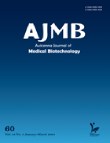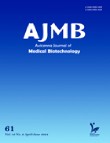فهرست مطالب

Avicenna Journal of Medical Biotechnology
Volume:16 Issue: 1, Jan--Mar 2024
- تاریخ انتشار: 1402/10/24
- تعداد عناوین: 9
-
-
Pages 3-8Background
SARS-CoV-2 as the cause of novel coronavirus disease (COVID-19) is a member of the family Coronaviridea that has generated an emerging global health concern. Controlling and preventing the spread of the disease requires a simple, portable, and rapid diagnostic method. Today, a standard method for detecting SARS-CoV-2 is quantitative real-time reverse transcription PCR, which is time-consuming and needs an advanced device. The aim of this study was to evaluate a faster and more cost-effective field-based testing method at the point of risk. We utilized a one-step RT-LAMP assay and developed, for the first time, a simple and rapid screening detection assay targeting the Envelope (E) gene, using specific primers.
MethodsFor this, the total RNA was extracted from respiratory samples of COVID-19 infected patients and applied to one-step a RT-LAMP reaction. The LAMP products were visualized using green fluorescence (SYBR Green I). Sensitivity testing was conducted using different concentrations of the designed recombinant plasmid (TA-E) as positive control constructs. Additionally, selectivity testing was performed using the influenza H1N1 genome. Finally, the results were compared using with conventional real time RT-PCR.
ResultsIt was shown that the RT-LAMP assay has a sensitivity of approximately 15 ng for the E gene of SARS-CoV-2 when using extracted total RNA. Additionally, a sensitivity of 112 pg was achieved when using an artificially prepared TA-E plasmid. Accordingly, for the detection of SARS-CoV-2 infection, the RT-LAMP had high sensitivity and specificity and also could be an alternative method for real-time RT-PCR.
ConclusionOverall, this method can be used as a portable, rapid, and easy method for detecting SARS-CoV-2 in the field and clinical laboratories.
Keywords: COVID-19, Detection, LAMP Assay, Real time PCR, SARS-CoV-2 -
Pages 9-15Background
Tilapia Piscidin 4 (TP4) showed potential anti-tumor effects against various cancer cells. Lycosine-1 (LYC1), is another Antimicrobial Peptides (AMP) from spider venom with targeted penetration to cancer cells without any adverse effects on normal cells. The aim of this study was to produce a soluble recombinant fusion peptide in order to diminish the cytotoxicity of TP4 against normal cells.
MethodsIn order to express of TP4-LYC-1, TP4, and LYC1 in fusion to the inteins1/2 of pTWIN-1 vector, induction condition was optimized to earn soluble peptides. Autocleavage induction of inteins1/2 was performed based on IMPACT® manual and their effect on cell viability of HeLa and HUVEC cells was surveyed by MTT assay.
ResultsThe best condition for accessing the most soluble peptide in fusion to the inteins was approximately similar for all three peptides (0.1 mM of IPTG, at 22°C). After the induction of self-cleavage of inteins, a band in 3, 3, and 6 kDa was observed on tricine- SDS-PAGE. The IC50 values of TP4-LYC1 and TP4 against HeLa cells were calculated as 0.83, and 2.75 μM, respectively.
ConclusionIn the present study, a novel chimeric peptide, TP4-LYC1, was successfully produced. This fusion protein can act as a safe bio-molecule with potent cytotoxic effects against cancer cells, but the penetration ability and determination of cell death mechanism must be performed in order to have more precise view on the apoptosis induction of this recombinant peptide.
Keywords: Cell survival, HeLa cells, Inteins, Spider venoms, Tilapia -
Pages 16-28Background
Repeated Ovum Pick Up (OPU) could have a detrimental effect on ovarian function, reducing In Vitro Embryo Production (IVEP). The present study examined the therapeutic effect of adipose–derived Mesenchymal Stem Cells (MSCs) or its Conditioned Medium (ConM) on ovarian trauma following repeated OPU. Resolvin E1 (RvE1) and Interleukin-12 (IL-12) were investigated as biomarkers.
MethodsJersey heifers (n=8) experienced 11 OPU sessions including 5 pre-treatment and 6 treatment sessions. Heifers received intra-ovarian administration of MSCs or ConM (right ovary) and Dulbecco’s Modified Phosphate Buffer Saline (DMPBS; left ovary) after OPU in sessions 5 and 8 and 2 weeks after session 11. The concentrations of RvE1 and IL-12 in follicular fluid was evaluated on sessions 1, 5, 6, 9, and 4 weeks after session 11. Following each OPU session, the IVEP parameters were recorded.
ResultsIntra-ovarian administration of MSCs, ConM, and DMPBS did not affect IVEP parameters (p>0.05). The concentration of IL-12 in follicular fluid increased at the last session of pre-treatment (Session 5; p<0.05) and remained elevated throughout the treatment period. There was no correlation between IL-12 and IVEP parameters (p>0.05). However, RvE1 remained relatively high during the pre-treatment and decreased toward the end of treatment period (p<0.05). This in turn was associated with decline in some IVEP parameters (p<0.05).
ConclusionIntra-ovarian administration of MSCs or ConM during repeated OPU did not enhance IVEP outcomes in Bos taurus heifers. The positive association between RvE1 and some of IVEP parameters could nominate RvE1 as a promising biomarker to predict IVEP parameters following repeated OPU.
Keywords: Animals, Biomarkers, Cattle, Conditioned medium, Follicular fluid, Inflammation, Interleukin-12, Ovary, Resolvin E1, Stem cells -
Pages 29-33Background
Orexin (hypocretin) is one of the hypothalamic neuropeptides that plays a critical role in some behaviors including feeding, sleep, arousal, reward processing, and drug addiction. Neurons that produce orexin are scattered mediolaterally within the Dorsomedial Hypothalamus (DMH) and the lateral hypothalamus. In the current research, we assessed the impact of prolonged application of the antagonist of Orexin Receptor 1 (OXR1) on nociceptive behaviors in adult male rats.
MethodsSixteen Wistar rats received subcutaneous (s.c.) injections of the OXR1 antagonist, SB-334867 (20 mg/kg, i.p.), or its vehicle repetitively from Postnatal Day 1 (PND1)-PND30. On the 30th day following the final application of the OXR1 antagonist formalin-provoked pain was evaluated by injecting formalin.
ResultsAdministration of the OXR1 antagonist in the long-term augmented the formalin- provoked nociceptive behaviors in interphase and phase II of the formalin-induced pain.
ConclusionCurrent results showed that the continued inhibiting OXR1 might be implicated in formalin-induced nociceptive behaviors. Therefore, the present study highlighted the effect of orexin on analgesia.
Keywords: Formalin, Nociception, Orexin receptor 1, Orexin, SB-334867 -
Pages 34-39Background
Multi-drug resistance is an important challenge in the chemotherapy of cancer. The role of annexin A5 (ANXA5) in the biology of cancer has been the focus of many studies. Breast Cancer (BC) is frequent cancer in women with high morbidity and mortality rate. The present study aimed to investigate the effects of ANXA5 overexpression on the anti-tumor activity of Epirubicin (EPI) in MCF-7 and MCF-7/ADR cells.
MethodsMCF-7 and MCF-7/ADR cells were transfected with the pAdenoVator- CMV-ANXA5-IRES-GFP plasmid or mock plasmid. The overexpression of ANXA5 was evaluated using qPCR. The effects of ANXA5 overexpression and EPI on the cell viability of MCF-7 and MCF-7/ADR cells were measured using an MTT assay. Cell apoptosis was measured by annexin V/7-AAD flow cytometry assay.
ResultsFollowing the overexpression of ANXA5, the viability of MCF-7 and MCF- 7/ADR was significantly decreased. Furthermore, the overexpression of ANXA5 in MCF-7 cells increased the cytotoxic effects of EPI in all doses and reduced the IC50 of EPI from 17.69 μM to 4.07 μM. Similarly, the overexpression of ANXA5 in MCF7- ADR cells reduced the IC50 of EPI from 27.3 μM to 6.69 μM. ANXA5 overexpression alone or combined with EPI treatment increased the apoptosis of MCF7 and MCF7- ADR cells.
ConclusionThe results of the present study demonstrate that ANXA5 overexpression increases the sensitivity of MCF-7 and MCF-7/ADR to EPI, suggesting a possible beneficial role of ANXA5 in the therapy of BC.
Keywords: Annexin-A5, Antineoplastic agents, Breast neoplasms, Drug resistance, MCF-7 cells -
Pages 40-48Background
Asparagine is an amino acid that can be converted into aspartic acid and ammonia by the enzyme L-asparaginase. Some forms of cancer, such Acute Lymphoblastic Leukaemia (ALL) and Non-Hodgkin Lymphoma (NHL), respond well to this enzyme when employed as a chemotherapeutic drug. The purpose of this research was to find bacteria that can manufacture the enzymes L-asparaginasein marine slattern sediment which can be employed in commercial and industrial scale production.
MethodsAll of the strains were identified as Bacillus niacini spp. by biochemical and molecular testing. The strain belongs to the Bacillus genus, according to nutritional, biochemical, PCR and 16srRNA sequencing data.
ResultsAccording to the findings of this research, Bacillus niacin spp. have the potential to create a substance that is helpful in a variety of medical applications. The results of this study hint to the possibility that bacteria have the ability to produce antimicrobial compounds, which have the potential to be successful in a wide variety of environments.
ConclusionNumerous opportunities may arise for researchers interested in utilizing the medical potential of enzyme-producing bacteria if they are successfully isolated and screened from aquatic and terrestrial habitats.
Keywords: Asparagine, Asparaginase, Bacillus niacini, Polymerase chain reaction -
Pages 49-56Background
The aim of this study was to determination of Anti-Quorum Sensing (AQS) and anti-biofilm potential of the methanol extract of ginger (Zingiber officinale) rhizomes against multidrug-resistant clinical isolates of Pseudomonas aeruginosa (P. aeruginosa).
MethodsThe AQS activity of ginger was determined against Chromobacterium violaceum (C. violaceum) ATCC 12472 (CV12472), a biosensor strain, in qualitative manner using the agar well diffusion method. The violacein pigment inhibition was assessed to confirm AQS activity of ginger. The AQS potential of sub-minimum Inhibitory Concentrations (sub-MICs) of the ginger extract was determined by targeting different QS regulated virulence factors, including swarming motility (using swarm diameter measurement method), pyocyanin pigment (using chloroform extraction method), Exopolysaccharide (EPS) (using phenol-sulphuric acid method), and biofilm formation (using microtiter plate assay), against clinical isolates (CIs 2, 3, and 4) and standard reference strain of P. aeruginosa (PA01).
ResultsThe AQS activity of methanol extract of ginger was confirmed against C. violaceum (CV12472) as inhibition of violacein pigment formation without effecting the growth of CIs and PA01 of P. aeruginosa. The ginger extract exhibited concentrationdependent inhibition of virulence factors and biofilm formation. The maximum reduction was found in swarming motility, pyocyanin, EPS and biofilm formation against PA01 (51.38%), CI3 (57.91%), PA01 (63.29%) and CI2 (64.37%), respectively at 1/2 MIC of ginger extract.
ConclusionThe results of present study revealed the effective AQS and anti-biofilm potential of Zingiber officinale rhizome methanol extract at a reduced dose (sub-MICs). The extract may be explored as an agent of antimicrobial compounds having AQS and anti-biofilm activity for controlling microbial infection and also for reducing the chances of emergence of resistance in P. aeruginosa.
Keywords: Chromobacterium violaceum, Ginger, Pseudomonas aeruginosa, Pyocyanin, Rhizome -
Pages 57-65Background
Acute Respiratory Distress Syndrome (ARDS) is a severe lung inflammatory condition that has the capacity to impair gas exchange and lead to hypoxemia. This condition is found to have been one of the most prevalent in patients of COVID-19 with a more serious condition. Green tea (Camellia sinensis L.) contains polyphenols that possess many health benefits. The purpose of this study was to assess the antiinflammatory activities of green tea extract in Lipopolysaccharide (LPS)-induced lung cells as ARDS cells model.
MethodsIn this study, rat lung cells (L2) were induced by LPS to mimic the inflammation observed in ARDS and later treated with green tea extract. Pro-inflammatory cytokines such as Interleukin (IL)-12, C-Reactive Protein (CRP) as well as Tumor Necrosis Factor-α (TNF-α) were investigated using the ELISA method. Gene expression of NOD-Like Receptor Protein 3 (NLRP-3), Receptor for Advanced Glycation Endproduct (RAGE), Toll-like Receptor-4 (TLR-4), and Nuclear Factor-kappa B (NF-κB) were evaluated by qRTPCR. Apoptotic cells were measured using flow cytometry.
ResultsThe results showed that green tea extract treatment can reduce inflammation by suppressing gene expressions of NF-κB, NLRP-3, TLR-4, and RAGE, as well as proinflammatory cytokines such as IL-12, TNF-α, and CRP, an acute phase protein. Apoptosis levels of inflamed cells also found to be lowered when green tea extract was administered; thus, also increasing live cells compared to non-treated cells.
ConclusionThese findings could lead to the future development of supplements from green tea to help alleviate ARDS symptoms, especially during critical moments such as the current pandemic.
Keywords: Acute respiratory distress syndrome, Camellia sinensis, Cytokines, Inflammation, Tea


